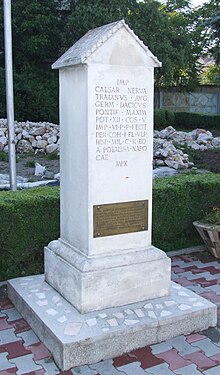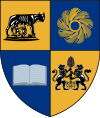|
Aiton, Cluj
Aiton (Hungarian: Ajton; German: Eiten) is a commune in Cluj County, Transylvania, Romania. It is composed of two villages, Aiton and Rediu (Rőd). GeographyThe commune is situated in the northern foothills of the Apuseni Mountains, at a mean altitude ov 626 m (2,054 ft). The presence of large deposits of halite and saltwater springs within the perimeter of the commune have been identified. Located in the central part of Cluj County county, Aiton belongs to the Cluj-Napoca metropolitan area. History Traces of several ancient neolithic settlements (of which Vinča culture from the 4th millennium BC), as well as evidence indicative of the Bronze Age, the Iron Age, the Roman conquest, and the Migration Period, were discovered in the village. Within the surrounding area, a tomb of incineration from the 1st century BC and a rustic villa have also been found; the latter in which a Dacian fruit tree from the 2nd century BC has been discovered. During the Roman period, the locality was situated on the Roman road of Potaissa-Napoca. Initially, a portion of the commune was left uncovered in the yard adjacent to the school, marked by a colonette reproducing the inscription on the milestone of 108. As of 2017, however, the site is covered in waste products. The area was historically the center of a Spanish equestrian unit. The first documented reference to the village of Aiton with the name Villa Ohthunth dates back to 1320, and in 1329, the toponym of Ahthon was attributed to the settlement. Since 1456, it appears under the current name of Ayton. In 1658, the locality was burned, following a Turkish and Tatar invasion. In the 18th century, a milestone named Aiton Biliar from the Roman period was discovered. This marked a distance on the Potaissa-Napoca. The landmark attests the existence of a road built in 108 AD by the Cohors I Hispanorum Miliaria. A copy of this landmark is displayed in Turda, yet another is displayed in front of the school of Aiton. On the Josephine Map of Transylvania from 1769 to 1773 (section 095), Aiton appears under the name of Ajton. The northern and southeastern parts of the village are marked by "Gericht" and by the sign of two public places of punishment of the delinquents in the medieval period. Historical monumentsThe following objectives of the village of Aiton were included on the list of historical monuments in Cluj County, elaborated further by the Ministry of Culture and Religious Affairs in 2010.
Places of worship
Tourist attractionsAmong the main tourist attractions and points of interest in the area are as follows:
EconomyThe predominant occupations of residents involve agriculture and the breeding of livestock. DemographicsEthnic demographics of population
Religious demographics of population
The numerical jump in favor of the Orthodox Church between 1930 and 1992 can be explained by the prohibition of the Greek Catholic Church in 1948 by the Communist government. Gallery
Notes
References
|
|||||||||||||||||||||||||||||||||||||||||||||||||||||||||||||||||||||||||||||||||||||||||||||||||||||||||||||||||||||||||||||||||||||||||||||||||||||||||||||||||||||||||||||||||||||||||||||||||||||||||||||||||||||||||||||||||||||||||||||||||||||||||||||||||||||||||||||||||||||||||||||||||||









